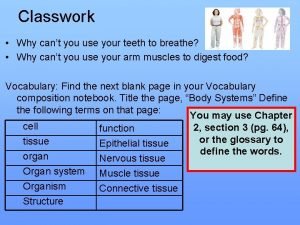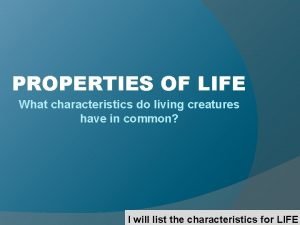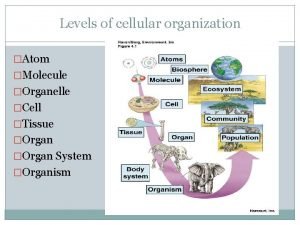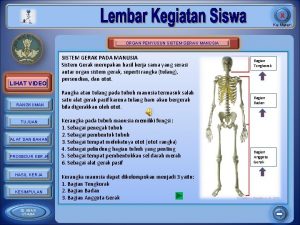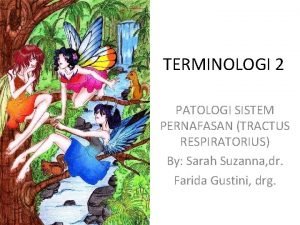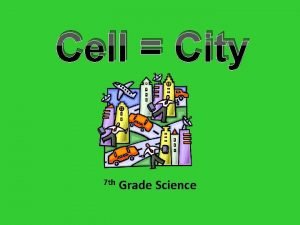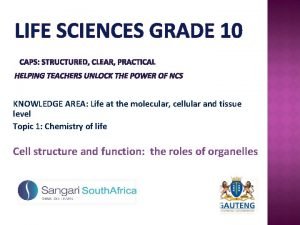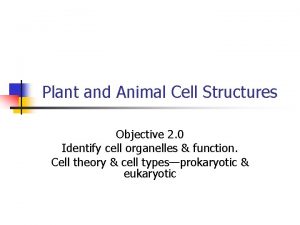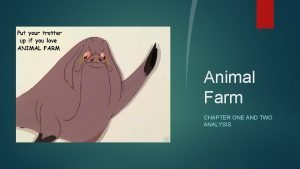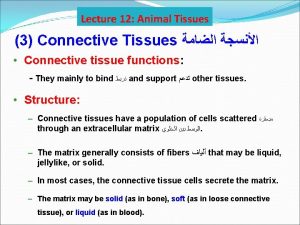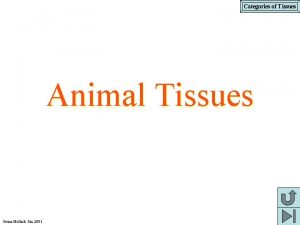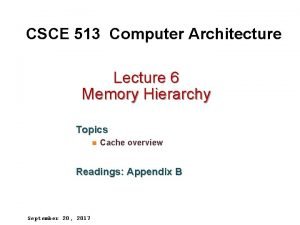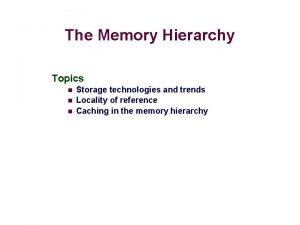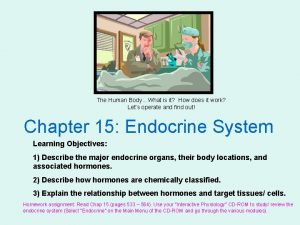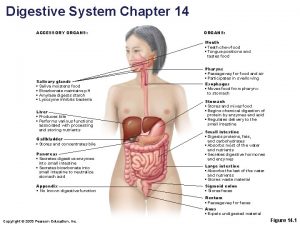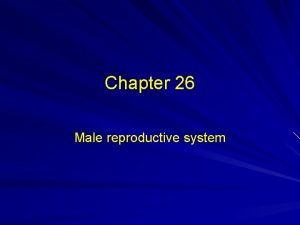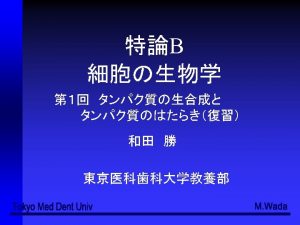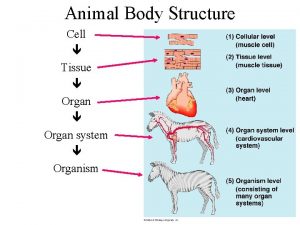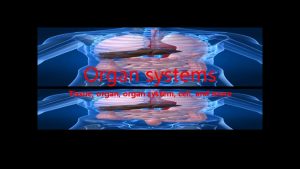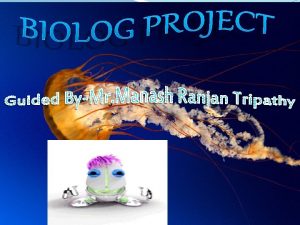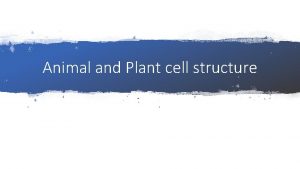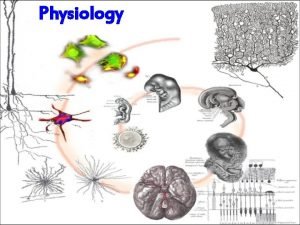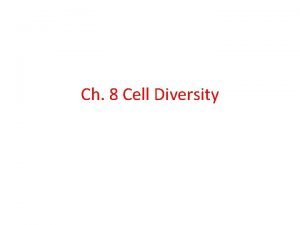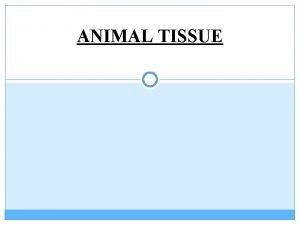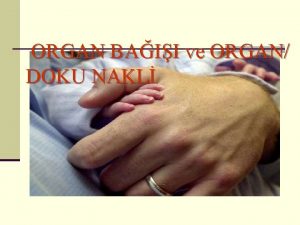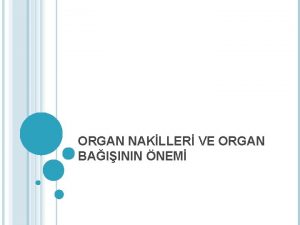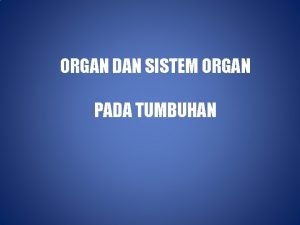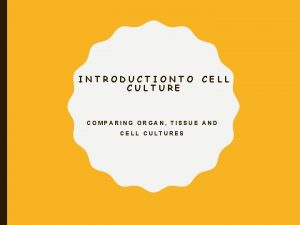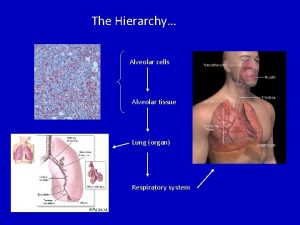Animal Architecture Structure Hierarchy Cell Tissue Organ System



































- Slides: 35

Animal Architecture

Structure Hierarchy • Cell Tissue Organ System

Cell Structure • Plasma membrane – Isolates cytoplasm from environment – Regulates molecular movement into and out of cell – Interacts with other cells/environment • Cytoplasm – Water, salts, organic monomers and polymers – Often contains organelles • Genetic material – DNA


Epithelial Tissue • Covers internal and external structures • Purpose – Protection – Secretion – Gas exchange • Basement membrane and connective tissue support epithelial tissue


Connective Tissue • Very diverse functions – Support – Energy storage – Gas exchange – Immune system Cartilage, bone, dense, loose Adipose Red blood cells White blood cells


Muscle Tissue • Contain contractile unit composed of actin and myosin fibers • Smooth • Striated – Skeletal – Cardiac

Smooth Muscle – Invertebrates • Body wall, ducts, sphincter – Vertebrates • Controls diameter of tubes (blood vessels and digestive system) • Involuntary

Striated • Densely packed actin/myosin fibers gives striated appearance • Multinucleated cells – syncytial • Skeletal – Found in both vertebrates and invertebrates – Attaches to bones and cartilage in vertebrates • Cardiac – Only found in vertebrate heart






Nervous Tissue • Neurons – send and receive signals • Neuroglia – support and protection


Metazoa • • • Multicellular Motile (at some point in life cycle) Heterotrophic (consumer) Diploid (two sets of chromosomes) Development proceeding via a blastula

Choanoflagellate Protozoan • Simple colonial flagellates • No specialization • Precursor to Metazoa

Spherical Colonies of Choanoflagellates • Reproduction of the whole cell aggregate through gametes • Cell specialization

Metazoa Classification

Three Basic Tissues • Ectoderm – Outer germ layer – Skin, nervous system, etc… • Mesoderm – Forms between ectoderm and endoderm – Connective tissue, muscle, vascular etc… • Endoderm – Innermost germ layer – Gastrointestinal tract

Eumetazoa

Animal Symmetry • Spherical – Radiolarians (protists) • Radial – Cnidarians (jellyfish) • Bilateral – Acoelomates (flatworms)

Symmetry

Developmental Patterns • Cleavage Pattern – Radial vs. Spiral – Regulative vs. Mosaic • Blastopore formation • Coelom formation

Mesoderm and Coelomic Formation

Protostomes Vs. Deuterostomes • Protostomes – – Molluscs Annelids Pseudocoelomates Acoelomates • Deuterostomes – Chordates – Echinoderms


Bilateria

Protostomes Body Plans

Segmentation • Body divided into somites (segments) • Phyla – Annelida – Arthropoda – Chordata

Cephalization • Concentration of nervous tissue – Development of brain and senses – Movement toward stimulus

Overview of Body Plans
 Cell tissue organ organ system organism
Cell tissue organ organ system organism Tissues group together to form
Tissues group together to form Cell tissue organ system body
Cell tissue organ system body Organ and organ system
Organ and organ system Molecule organelle cell
Molecule organelle cell Gambar penyusun sistem gerak
Gambar penyusun sistem gerak Organ organ pernafasan
Organ organ pernafasan Organ penyusun sistem koordinasi
Organ penyusun sistem koordinasi Spongebob cell analogy
Spongebob cell analogy Plant vs animal cells
Plant vs animal cells Venn diagram plant vs animal cells
Venn diagram plant vs animal cells Vacuole function
Vacuole function Is cytoplasm in plant and animal cells
Is cytoplasm in plant and animal cells Cell city introduction
Cell city introduction Eukaryotic cell animal cell
Eukaryotic cell animal cell Idealized animal cell and plant cell
Idealized animal cell and plant cell Animal cell and plant cell
Animal cell and plant cell Animal cell structure under electron microscope
Animal cell structure under electron microscope Animal cell structure grade 10
Animal cell structure grade 10 Parts of an animal cell
Parts of an animal cell Perforation plates
Perforation plates Animal farm hierarchy pyramid
Animal farm hierarchy pyramid Loose connective tissue
Loose connective tissue Animal tissue
Animal tissue Mucous connective tissue
Mucous connective tissue Epithelial tissue
Epithelial tissue Adipose connective
Adipose connective Cell tissue
Cell tissue Memory hierarchy in computer architecture
Memory hierarchy in computer architecture Computer memory hierarchy
Computer memory hierarchy Memory hierarchy in computer architecture
Memory hierarchy in computer architecture Animal rights vs animal welfare
Animal rights vs animal welfare The human bodywhat is an organ system?
The human bodywhat is an organ system? Mouth function in digestive system
Mouth function in digestive system Base of prostate gland
Base of prostate gland Plant organ
Plant organ
